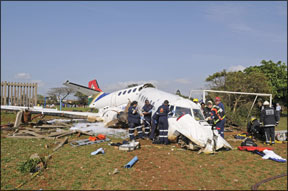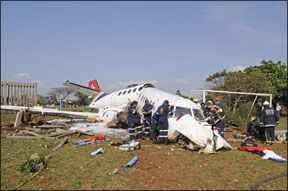A recent spate of high-profile runway excursions involving airline operations got me thinking: Runway overruns are not a topic on which the average GA pilot receives much comprehensive instruction during flight training. The pros have operational policies providing the parameters and protocols by which takeoffs and landings must be done each and every time. But for the rest of us not flying the big iron in 288 conformity to op specs, theres no similar, systematic defense strategy utilized against running into the ditch. In fact, the varied nature of GA flying itself-sporadic flights, from local VFR practice to an IFR cross-country-actually presents a greater challenge than that done by the pros flying the same bus route day in and day out. So how can the chance of an excursion on takeoff or landing when flying GA craft be reduced? As a start, excursions are often associated with identifiable risk factors. Although the risk factors cant be eliminated, once identified, they can be defended against, thereby reducing the potential for an excursion. Defining the problem First, lets take a look at the nature of the problem. Excursions can be divided into two basic categories: veer-offs and overruns. Either can occur in the takeoff or landing phase. (This article addresses takeoff excursions; landing excursions will be dealt with in a follow-up.) Not surprisingly, more excursions occur on landing than takeoff. According to the AOPA Air Safety Foundations latest Nall Report, there were approximately 413 landing accidents in 2008, a number that has remained relatively consistent over the last 10 years. Forty-nine percent involved loss of directional control. Included in the total were those other than excursions (such as stalls, presumably over the runway and gear malfunctions) but the stat provides some perspective nonetheless. For commercial ops, runway-related accidents accounted for 30 percent of all accidents, according to a 2009 Flight Safety Foundation report. Of those, 97 percent were excursions. On the GA side, theres no shortage of NTSB reports that come up under the search term “excursion.” Moreover, its a safe bet that the number of GA excursions is even greater given many dont result in an incident or accident and thus dont hit the NTSBs (or CNNs) radar screens. Fortunately, most landing accidents arent deadly, given that they occur at relatively reduced speeds. Less than five percent involve fatalities. But repair costs, down time and adrenaline detox are not insignificant, and thus worth guarding against. Taking aim Before an approach to reducing excursions on takeoff can be developed, two preliminary questions must be addressed: The first is, what are the markers of a safe takeoff? And, second, what are the risk factors for an excursion on takeoff? For the most part, a good takeoff is one that gets you off the runway and headed up hill on a reasonably straight path. But for the purpose of fending off an excursion, the metrics need to be more precise. First, directional control from power-up to liftoff must keep the nosewheel on the stripes and nowhere else. Liftoff-or rotation in turbine-powered airplanes-must occur at the proper speed, one either specified during preflight planning or one providing minimal time transitioning to a positive climb rate. Coming off the pavement, speed must be adequate to ensure immediate positive control, perhaps including an additive for the crosswind component and potential gusts. On the initial climb, airspeed needs to be pegged within a margin of best rate to plus 10 knots above for the first 1000 feet. Pitch should be consistently positive, as should vertical speed. Gear and flaps must be retracted once a climb is assured. An accident scenario Lets first walk through a scenario that poses an excursion risk against which defensive tactics could be applied. Cleared for takeoff, you power up and start rolling down the runway. Just prior to lifting off, your glass panel goes dark-or, insert any other event from the list in the sidebar at right. You spend a few seconds in disbelief before you pull the power. By that time, youre past liftoff speed and have no idea how much runway remains. Youve chosen to abort, but as you pull the power to idle, you notice youve burned through to the end of the runway, which now is in sight. Standing on the brakes starts slowing the airplane, but also creates an asymmetric pull, eventually resulting in a ground loop off the runways departure end. Fortunately, only the landing gear collapses. Along with your ego. Playing defense on takeoff What could have provided a greater margin of safety to prevent this type of mishap? First, having the right mindset is key. Typically, most pilots view takeoffs with less apprehension than landings. This is despite there being much greater energy to dissipate on a takeoff roll when something “bad” happens versus a landing. One the result is that your mental defenses are lowered on takeoff. In response, when pushing in the power, also ramp up your alertness for the unexpected. Its better to be spring-loaded for an unexpected event that doesnt occur than the reverse. That way, when something does happen, you dont lose precious seconds overcoming the startle factor. Next, get a good start off the blocks. I see many pilots entering the runway and jamming in the power without ever getting lined up on the centerline. If you dont start there, you lose the opportunity to establish a ready baseline to check for rudder effectiveness against any crosswind interference or other anomaly, such as an induced side-load from improper control inputs. Moreover, if youre struggling to hold the centerline before lifting off because of a strong crosswind, prudence may well dictate rejecting the takeoff. Get a good early read on the gauges. On a recent takeoff, I noticed that after adding full power, RPM was 400 below redline. I immediately pulled the power and was at taxi speed within several hundred feet. I had quickly ascertained the problem because my practice is to check for max manifold pressure, rpm and full-power fuel flow on the initial roll. If you wait until close to liftoff speed for those checks, workload to stay on the line goes up significantly should the need to abort arise. Another disconcerting event is lifting off and expecting a climb that doesnt materialize because you failed to set takeoff flaps. In most GA planes, this can be overcome by letting the airspeed build up to where sufficient lift is developed even without flaps. Part of getting a good start to any takeoff is double-checking your flap setting. I have added this item to a custom checklist, which includes a final review of so-called “killer” items before taking the runway for takeoff. On this list also is a check ensuring the autopilot is not engaged. Several years ago, I was getting close to rotating and the wheel was dead stiff. The control check prior to initiating takeoff was fine, so I thought something had lodged in a control linkage given that there was nearby taxiway construction in progress. After successfully rejecting the takeoff, the autopilot was fingered as the problem. It likely got turned on after getting bumped with a knee board. It doesnt hurt to hit the yoke-mounted disconnect when taking the runway just to be sure. Relatedly, ensure that your non-pilot right seat passenger isnt using the rudders as a footrest. Mistaking stiff rudder input as a crosswind rather than dead foot in the right seat can be a problem. And, of course, theres no reason for any pilot to have his feet up on the toe brakes on the roll that could allow differential resistance when a rudder input is made. Many readers no doubt have had the experience of rolling down the runway or lifting off with a seat sliding back. Years ago, it was a serious issue on certain Cessna models, requiring an airworthiness directive and giving rise to aftermarket fixes. Once buckled up, giving the seat a good front-to-back motion is always worth the effort. What Else Can You Do? As in the above rejected-takeoff scenario, its important to know by what point on the runway it needs to happen, if theres a choice. Being aware of how much runway is required to accelerate for liftoff is key to knowing the remaining stopping distance. Many pilots never identify a takeoff marker, or are so fixated on airspeed or the power setting they dont realize theyve eaten up more than half the runway on their roll. Its imperative to have situational awareness of the remaining runway distance to make an informed choice on whether to abort or limp away. To combat a loss of control or upset during liftoff, ensure an adequate speed is developed for positive control after the nose is first rotated. Ive witnessed many pilots lifting off at or near the stall only to drop back to terra firma. Personally, I add 5-10 knots over book so that the transition from rolling to flying is solid and crisp (assuming no need for a short-field takeoff). Without that margin, a sudden gust or loss of headwind means surfing on the edge of a stall. With a stall, one wing will likely drop first, adding to the potential for a loss of directional control. Another place to gain a margin of control is by taking advantage of ground effect. It seems the last time many pilots thought about ground effect was when watching their first flight training video. Not only does ground effect enhance lift by some 10-15 percent, it also aids in acceleration. Conversely, trying to pop out of ground effect too soon with a high angle of attack and youre closer to a stall, especially should a wing dip and reduce available lift further. Instead of going for a max-rate climb with the stall horn blaring, stay down on the deck until youve accelerated past your best climb rate speed and then pitch up for departure. Maintain your margin As in competitive sports, the difference between winning and losing often occupies a small margin on the field. All the more so with a playing field only 50-75 feet wide at times. To improve your odds of staying in the game, plan your defense and fly your plan. Mark Pestal, a commercial multi-engine pilot, mostly flies off the centerline at several Denver airports.




